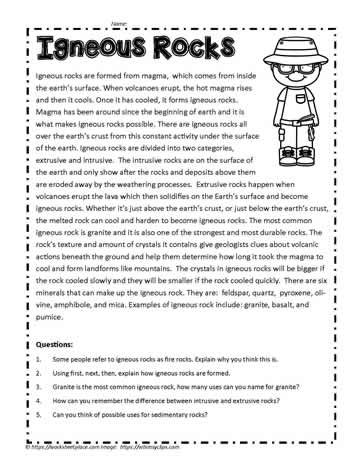| |||||
| Igneous Rocks Comprehension For Google Apps | |||||
| Igneous rocks are formed from magma from inside the earth's surface. Have your students read this sheet to find out more information about igneous rocks. When volcanoes erupt, the hot magma rises and then it cools. Once it has cooled, it forms igneous rocks.Magma has been around since the beginning of earth and it is what makes igneous rocks possible. There are igneous rocks all over the earth’s crust from this constant activity under the surface of the earth. Igneous rocks are divided into two categories,extrusive and intrusive. The intrusive rocks are on the surface of the earth and only show after the rocks and deposits above them are eroded away by the weathering processes. Extrusive rocks happen when volcanoes erupt the lava which then solidifies on the Earth’s surface and become igneous rocks. Whether it’s just above the earth’s crust, or just below the earth’s crust, the melted rock can cool and harden to become igneous rocks. The most common igneous rock is granite and it is also one of the strongest and most durable rocks. The rock’s texture and amount of crystals it contains give geologists clues about volcanic actions beneath the ground and help them determine how long it took the magma to cool and form landforms like mountains. The crystals in igneous rocks will be bigger if the rock cooled slowly and they will be smaller if the rock cooled quickly. There are six minerals that can make up the igneous rock. They are: feldspar, quartz, pyroxene, olivine, amphibole, and mica. Examples of igneous rock include: granite, basalt, and pumice. Questions: 1. Some people refer to igneous rocks and fire rocks. Explain why you think this is. 2. Using first, next, then, explain how igneous rocks are formed. 3. Granite is the most common igneous rock, how many uses can you name for granite? 4. How can you remember the difference between intrusive and extrusive rocks? 5. Can you think of possible uses for sedimentary rocks? | |||||

All worksheets are created by experienced and qualified teachers. Send your suggestions or comments.